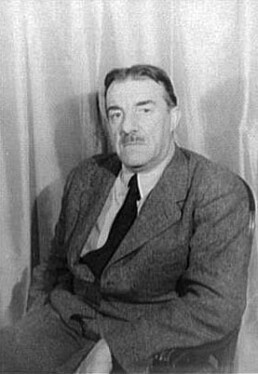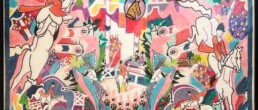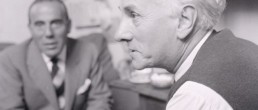Fernand Léger
1881 (Argentan) - 1955 (Gif-sur-Yvette)
No work available for the moment.
Biography
Léger was born in Argentan, where his father raised cattle. Fernand Léger initially trained as an architect from 1897 to 1899, before moving in 1900 to Paris, where he supported himself as an architectural draftsman. After military service in Versailles, in 1902–1903, he enrolled at the School of Decorative Arts after his application to the École des Beaux-Arts was rejected. He nevertheless attended the Beaux-Arts as a non-enrolled student, spending what he described as “three empty and useless years” studying with Gérôme and others, while also studying at the Académie Julian. He began to work seriously as a painter only at the age of 25. At this point his work showed the influence of impressionism. A new emphasis on drawing and geometry appeared in Léger‘s work after he saw the Cézanne retrospective at the Salon d’Automne in 1907.
In 1909 he moved to Montparnasse and met Alexander Archipenko, Jacques Lipchitz, Marc Chagall, Joseph Csaky and Robert Delaunay.
In 1910 he exhibited at the Salon d’Automne in the same room (salle VIII) as Jean Metzinger and Henri Le Fauconnier. In his major painting of this period, Nudes in the Forest, Léger displays a personal form of Cubism that his critics termed “Tubism” for its emphasis on cylindrical forms.
In 1911 the hanging committee of the Salon des Indépendants placed together the painters identified as ‘Cubists‘. Metzinger, Albert Gleizes, Le Fauconnier, Delaunay and Léger were responsible for revealing Cubism to the general public for the first time as an organized group.
The following year he again exhibited at the Salon d’Automne and Indépendants with the Cubists, and joined with several artists, including Le Fauconnier, Metzinger, Gleizes, Francis Picabia and the Duchamp brothers, Jacques Villon, Raymond Duchamp-Villon and Marcel Duchamp to form the Puteaux Group—also called the Section d’Or (The Golden Section).
Léger‘s paintings, from then until 1914, became increasingly abstract. Their tubular, conical, and cubed forms are laconically rendered in rough patches of primary colors plus green, black and white, as seen in the series of paintings with the title Contrasting Forms.
Léger‘s experiences in World War I had a significant effect on his work. Mobilized in August 1914 for service in the French Army, he spent two years at the front in Argonne. He produced many sketches of artillery pieces, airplanes, and fellow soldiers while in the trenches, and painted Soldier with a Pipe (1916) while on furlough. In September 1916 he almost died after a mustard gas attack by the German troops at Verdun. During a period of convalescence in Villepinte he painted The Card Players (1917), a canvas whose robot-like, monstrous figures reflect the ambivalence of his experience of war. As he explained :
“…I was stunned by the sight of the breech of a 75 millimeter in the sunlight. It was the magic of light on the white metal. That’s all it took for me to forget the abstract art of 1912–1913. The crudeness, variety, humor, and downright perfection of certain men around me, their precise sense of utilitarian reality and its application in the midst of the life-and-death drama we were in … made me want to paint in slang with all its color and mobility.“
This work marked the beginning of his “mechanical period“, during which the figures and objects he painted were characterized by sleekly rendered tubular and machine-like forms. Starting in 1918, he also produced the first paintings in the Disk series, in which disks suggestive of traffic lights figure prominently. In December 1919 he married Jeanne-Augustine Lohy, and in 1920 he met Le Corbusier, who would remain a lifelong friend.
The “mechanical” works Léger painted in the 1920s, in their formal clarity as well as in their subject matter—the mother and child, the female nude, figures in an ordered landscape—are typical of the postwar “return to order” in the arts, and link him to the tradition of French figurative painting.
They also share traits with the work of Le Corbusier and Amédée Ozenfant who together had founded Purism, a style intended as a rational, mathematically based corrective to the impulsiveness of cubism.
As an enthusiast of the modern, Léger was greatly attracted to cinema, and for a time he considered giving up painting for filmmaking. In 1924, in collaboration with Dudley Murphy, George Antheil, and Man Ray, Léger produced and directed the iconic and Futurism-influenced film Ballet Mécanique (Mechanical Ballet).
In collaboration with Amédée Ozenfant he established the Académie Moderne, a free school where he taught from 1924, with Alexandra Exter and Marie Laurencin. He produced the first of his “mural paintings“, influenced by Le Corbusier‘s theories, in 1925. Intended to be incorporated into polychrome architecture, they are among his most abstract paintings, featuring flat areas of color that appear to advance or recede.
Starting in 1927, the character of Léger‘s work gradually changed as organic and irregular forms assumed greater importance.
In 1931, Léger made his first visit to the United States, where he traveled to New York City and Chicago. In 1935, the Museum of Modern Art in New York presented an exhibition of his work. In 1938, Léger was commissioned to decorate Nelson Rockefeller’s apartment.
During World War II Léger lived in the United States. He taught at Yale University, and found inspiration for a new series of paintings in the novel sight of industrial refuse in the landscape. The shock of juxtaposed natural forms and mechanical elements, the “tons of abandoned machines with flowers cropping up from within, and birds perching on top of them” exemplified what he called the “law of contrast”.
During his American sojourn, Léger began making paintings in which freely arranged bands of color are juxtaposed with figures and objects outlined in black. Léger credited the neon lights of New York City as the source of this innovation : “I was struck by the neon advertisements flashing all over Broadway. You are there, you talk to someone, and all of a sudden he turns blue. Then the color fades—another one comes and turns him red or yellow.”
Upon his return to France in 1945, he joined the Communist Party. During this period his work became less abstract, and he produced many monumental figure compositions depicting scenes of popular life. His varied projects included book illustrations, murals, stained-glass windows, mosaics, polychrome ceramic sculptures, and set and costume designs.
After the death of Leger‘s wife Jeanne-Augustine Lohy in 1950, Léger married Nadia Khodossevitch in 1952. In his final years he lectured in Bern, designed mosaics and stained-glass windows for the Central University of Venezuela in Caracas, Venezuela, and painted Country Outing, The Camper, and the series The Big Parade. In 1954 he began a project for a mosaic for the São Paulo Opera, which he would not live to finish. Fernand Léger died at his home in 1955 and is buried in Gif-sur-Yvette, Essonne.






